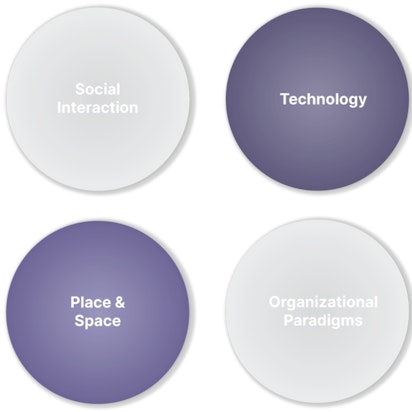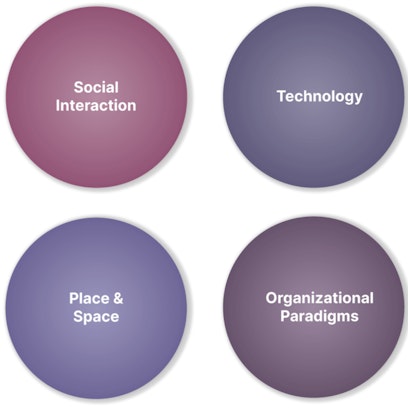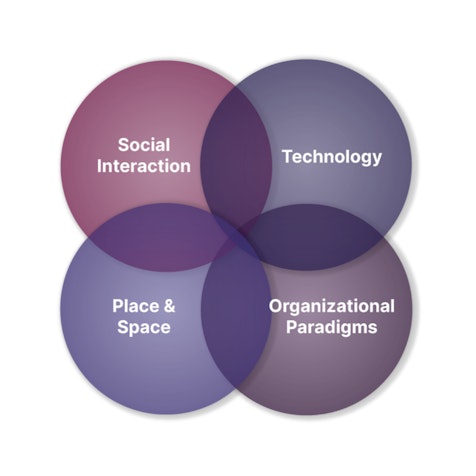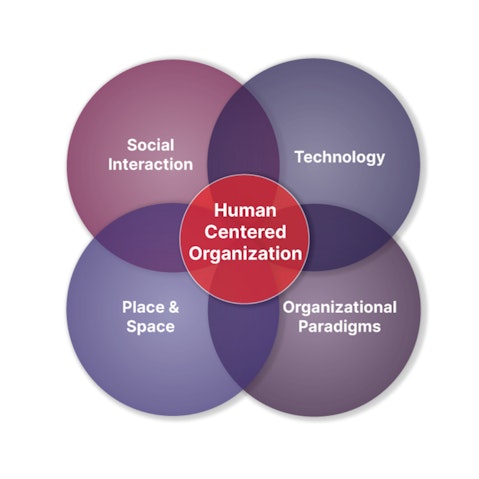Why neither space nor tech can really solve hybrid meetings
As companies struggle to provide digital equality in the hybrid work era, are we looking at the challenge from the wrong angle? Canada’s ET Group believes the answer lies with underlying organisational culture and behaviours
One of the key challenges facing employers in the new world of work is to provide ‘digital equality’ in hybrid meetings so that everyone has the same high-quality experience irrespective of whether they have joined remotely or are attending in-person at the office. Too often, that’s not happening.
To be clear, things have improved since before the global pandemic. Cast your mind back to when most employees turned up on site for meetings and remote participants were second-class citizens reduced to a tiny slate on a screen at the far end of the room and excluded from conversation by papers being placed on top of the conference phone.
Today, such substandard practices are beginning to disappear. That’s good news, but we’ve still got a long way to go. Things are not improving fast enough. Despite heavy investment in new technologies and new spaces, companies are still struggling to get hybrid meetings right. Why should this be the case?
Missing from the conversation
Canadian workplace technology designer and integrator ET Group is working on digital communication projects with a range of large clients in North America. According to CEO Dirk Propfe, there’s something fundamental missing from the debate about hybrid meetings that is impeding progress.
‘We’ve clearly advanced with technology and we’re starting to improve spaces and places,’ explains Propfe, who adds that ‘both are necessary, but not sufficient elements to have conversations in an inclusive and productive way. Hybrid meetings were forged in the fire of an emergency with the pandemic, but we’ve not yet dug deeper. Just focusing on tech and space leaves a huge blind spot to the equation.’
‘We’ve not yet dug deeper into the fundamentals of all good hybrid collaboration’ – Dirk Propfe, ET Group
ET Group believes that those fundamentals, which are often overlooked, are rooted in the dynamics of social interaction and organisational paradigms, as well as in the technologies or settings that firms provide. As ET Group’s Strategic Business Lead Colby Harder observes: ‘You could have the best tech and the best spaces, but if the social and organisational undercurrents are not addressed, you’re missing a big piece of the conversation and you’re not going to achieve more inclusion and digital equality.’
Four pillars to focus on
Digital equality in hybrid meetings is essentially about giving everyone an equal seat at the table so they can not only be seen and heard but also included and encouraged to contribute their best work. ET Group has developed a theoretical model to explain its thinking. This describes four main pillars, with social interaction and organisational paradigms sitting alongside technology and space. Bringing these four pillars together is essential to approach the challenges around new ways of working and organising with a whole systems perspective.
ET Group Senior Consultant Stephan Berchtold explains: ‘Hybrid meetings are just the tip of the iceberg. Under the surface, organisational paradigms have become so ingrained and built into models of leadership that they have become unapproachable and undiscussable. What is often needed is a shift of perspective by leadership to allow for necessary conversations to happen.’ To explain, ET Group shares its observation of organisations approaching the challenges around new ways of working.
1 Focused on tech and space only

In a first-step approach, organisations will focus on technology as well as place and space. The rest goes unattended. This, ET Group has observed, might even happen with little to no connection of the organisational entities in charge of tech and place, respectively. It is quite common that one person drives the effort with no connection to other key players from other areas or different people drive different areas without sharing or learning together. This can also be part of turf wars, where other perspectives are devalued. Fortunately, it is more common that organisations approach tasks in these two areas, tech and space, together. What’s often missing, however, is employee involvement.
2 Awareness of evolving ways of working

In a second evolution, a more holistic approach is taken, with conversations taking place not just around creating new buildings or providing new tech, but also how the nature of work is shifting. This includes challenging long-held and often non-negotiable assumptions around work. It might also mean revisiting the roles of managers and leaders. Still, many of the conversations happen in isolation, not connecting the dots due to not going deep enough. A practical example is organisations installing all the latest tech, which excites IT experts. But without adequate training to use the tech and to host differently, it leaves the meeting host feeling overwhelmed and prone to failure (i.e. a poor hybrid meeting experience).
3 Considering whole picture in workplace planning
 With further enlightenment, organisations start talking about the whole picture, understanding how the underlying elements of social interaction and organisational paradigms interplay with the elements on the surface (tech and place), and how each of these four elements mutually influence one another. And, what really seems to tick the needle, this includes engaging employees and their needs. A term often used to describe this engagement is ‘recontracting’, or re-negotiating the underlying contract. A practical example is to understand how the hierarchy is constantly reinforced by the way meetings are held. Managers must understand that they need to host meetings differently to honestly allow for the open sharing of different perspectives.
With further enlightenment, organisations start talking about the whole picture, understanding how the underlying elements of social interaction and organisational paradigms interplay with the elements on the surface (tech and place), and how each of these four elements mutually influence one another. And, what really seems to tick the needle, this includes engaging employees and their needs. A term often used to describe this engagement is ‘recontracting’, or re-negotiating the underlying contract. A practical example is to understand how the hierarchy is constantly reinforced by the way meetings are held. Managers must understand that they need to host meetings differently to honestly allow for the open sharing of different perspectives.
4 Evolving to a human-centered organisation
 Regarding efforts to evolve ways of working and change behaviour to adopt a more human-centred approach, ET Group observes that it is much harder for large organisations to progress such discussions and make changes. More often, it is medium-sized and smaller organisations who are examining and evolving their ways of working—with a high correlation of eventually moving towards a more human-centred organisational paradigm.
Regarding efforts to evolve ways of working and change behaviour to adopt a more human-centred approach, ET Group observes that it is much harder for large organisations to progress such discussions and make changes. More often, it is medium-sized and smaller organisations who are examining and evolving their ways of working—with a high correlation of eventually moving towards a more human-centred organisational paradigm.
From controlling to hosting
Summarising ET’s model, Dirk Propfe believes that ‘placing all the emphasis on technical sound and vision – important as those are – without considering issues of social interaction and organisational paradigms, could be holding companies back.
Stephan Berchtold provides an example: ‘If we look at managers, we see that many try to have the same kind of meeting they had before, the only difference being that part of the team is now remote. Even if tech and place allow for a high-quality experience, it still misses the point. The difference comes from the approach taken: do you want to control the meeting or host it? Unless you change the design of the meeting to host instead of control, it will be hard to include participants and create digital equality.’
Berchtold adds: ‘Let’s just take the conversations organisations have with their employees. Do they have parent-child conversations or are these adult-to-adult interactions? The invitation to participate on a level playing field is linked to psychological comfort at work. Currently, too many workers don’t feel psychologically safe and when hybrid meetings misfire, they are like the canary in the coalmine – they tell stories about things going wrong inside your organisation. ’
Consequences of poor meetings
The consequences for companies of a poor hybrid meeting experience are significant. ET Group has observed that, in the short term, it might be individuals and teams that suffer due to inefficiencies that obstruct project milestones. But in the longer term, the organisation itself begins to suffer as internal culture fragments, identity weakens and business clients are lost.
Dirk Propfe offers a quick test: ‘Just have a look at how many of the remote participants have their camera off, and then count those onsite who are distracted with their smartphone. This gives you a quick measure of inclusion and engagement.’
A poor hybrid meeting experience can mean several things for employees: take, for instance, the loss of control over contribution and influence, or a lack of respect they may experience. With regards to loss of control, this ties into WORKTECH Academy’s review of the academic literature in environmental and workplace psychology: having a sense of control and receiving positive messages of respect via the physical work environment are very important to worker performance and morale.
Consider the experience of people working mainly at home during the pandemic: Many had an upsurge in personal control over their environment. Urged to come back to the office, not only do employees feel excluded from decisions that impact the way they work, but they also experience a loss of control over their environment.
Add to this the fact that, in many organisations, meeting practices have not evolved yet. A bad hybrid meeting experience can easily contribute to the feeling of not being seen, not being included, not being valued. The pain points of the hybrid workplace are reinforcing this sentiment of disenchantment. Dirk Propfe observes that ‘the more of a sense of control you feel that you have, the more autonomy, flexibility and courage you have’.
ET Group’s message is that the issue of meeting equality is not independent from what’s going on beneath the surface of the company. While the technical and spatial aspects of hybrid meetings matter, the beliefs that underpin the structure of an organisation – those organisational paradigms – and the associated behaviours that align with those ways of thinking are perhaps what matter most.
According to ET Group’s Colby Harder, some clients learn from their struggles with hybrid meetings while others resist: ‘If they insist it won’t work, then it really won’t work’.
In a next article we will cover more on the role of social interactions and organisational paradigms as well as some tips for practical application.
To find out more about ET Group’s approach watch the video below.








